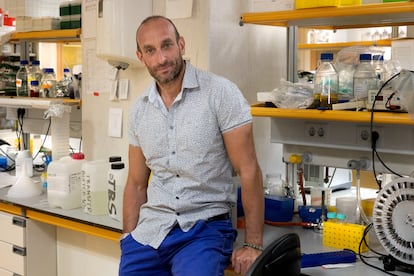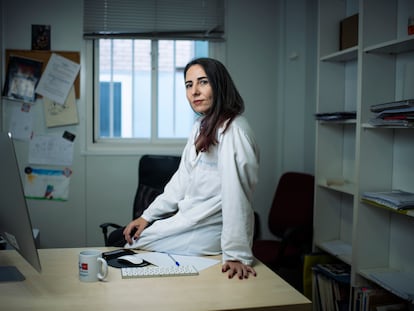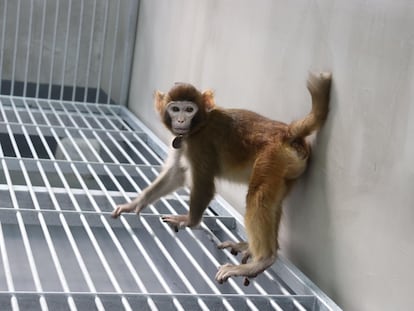Relics of ancient viral DNA guide embryo development
A study in mice reveals the surprising role that viral infections from millions of years ago play today

Every person begins as a single cell — a fertilized egg — and grows into an impressive being made of some 30 trillion cells, each of them specialized in a task: be it transporting oxygen in the blood, contracting in the muscle or transmitting thoughts in the brain. That first single cell is totipotent: it has the ability to produce an independent organism. When it divides, the two resulting cells are totipotent, but in the next multiplication things change, according to animal studies. These four cells are no longer totipotent, but pluripotent: they can turn into any type of cell in the organism, but not into an independent organism. A team from the National Cancer Research Center (CNIO) in Madrid has now discovered, in mouse embryos, a surprising actor in this fundamental stage of development: the relics of viruses that infected primitive organisms hundreds of millions of years ago, embedded in the animal’s DNA.
More than 8% of the human genome is made up of this virus genetic material, which has been integrated since time immemorial. Researcher Sergio de la Rosa, the lead author of the study, and his colleagues observed in mice that one of these past invaders — the endogenous retrovirus MERVL — acts as conductor in cells’ necessary transition from totipotency to pluripotency. “Until recently, these viral remnants were considered to be ‘junk DNA,’ genetic material that was unusable or even harmful,” he explained in a statement. “Intuitively, it was thought that having viruses in the genome could not be good. However, in recent years we are starting to realize that these retroviruses, which have co-evolved with us over millions of years, have important functions, such as regulating other genes. It’s an extremely active field of research.”
French pharmacologist Nabil Djouder, leader of the CNIO group, has been studying the URI protein — which is associated with various types of cancer, such as liver and ovarian cancer — for more than two decades. Previous studies by Djouder suggested that if the levels of this protein moved beyond a narrow threshold, it could either trigger a tumor or prevent it, depending on the context. Balance is key. Now the latest study shows that URI protein activity is key for other molecules to convert the cell into pluripotent. If URI does not act, the cell remains totipotent. Researchers believe that understanding this process in embryo development will help understand the similar mechanisms that operate in cancer development.
The work, published on Wednesday in the journal Science Advances, reveals that, when the mouse embryo has only two totipotent cells, endogenous retroviruses take action. A protein of viral origin — MERVL-gag — binds to the URI and inactivates it. As embryonic development continues, viral protein levels decline and URIs intervene, leading to pluripotency. “Our findings reveal the symbiotic coevolution of endogenous retroviruses with their host cells to ensure the smooth and timely progression of early embryo development,” the authors concluded in the study. Thanks to the relic of a virus dating back to time immemorial, the embryo’s cells can continue onwards in their development.
Djouder said that it is “a totally new role for endogenous retroviruses.” In his opinion, this finding may be useful in the field of regenerative medicine and the creation of embryo models for scientific research, since it opens a new way to control totipotent cells and produce stable cell lines in the laboratory.
Enigma in humans
Biologist Marta Shahbazi explains that totipotency in mouse embryos is lost at the four-cell stage, meaning the cells can no longer produce an individual organism. “In humans it is not known [when this happens], because no one has done the experiment,” said the Spanish researcher, who studies human embryos at the Laboratory of Molecular Biology, in Cambridge, in the United Kingdom. “There is work that suggests that at the two-cell stage there are already molecular differences between them, but it is not known what this implies in functional terms, in the ability to form an organism.”
Shahbazi points out that the CNIO team has discovered that, if the URI protein is eliminated, the cells are blocked at the earliest phase of development: totipotency. “In order to use these cells in regeneration and embryonic modeling, the next step would be to demonstrate whether these cells have greater potential, and to develop methods so that they can mimic the early stages of development,” she explained.
Biologist Miguel Manzanares applauds the new work. “These endogenous retroviruses are inserted into the genome and stay there. They are like a fossil footprint. The curious thing is that they are species-specific. It is not as if something happened to a common ancestor of humans and mice and the mechanism was maintained. These are mouse-specific,” explained Manzanares, from the Severo Ochoa Molecular Biology Center (CSIC) in Madrid, who did not take part in the research. The researcher points out that endogenous HERVL retroviruses — equivalent in humans to mouse MERVL — are also activated in human totipotent cells. And embryonic development in this early phase is similar in rodents and people. “How do you explain that one of the key players in this process is species-specific? That’s the question on the table,” he said.
Researcher Francisco José Sánchez Luque underscores the flexibility of the evolutionary process of living beings. “At first they were infectious, pathogenic viruses, but they became excellent material for evolution to work with. There are a lot of regulatory sequences that have been recycled to do other functions, for example, in the human immune system itself. Retrovirus sequences have been recycled to defend against other retroviruses,” explained the biologist who directs the Molecular Genetics of Mobile and Foreign DNA group at the López-Neyra Institute of Parasitology and Biomedicine, in Granada, Spain.
He added: “This study shows that one of the proteins of a retrovirus that was integrated into DNA has been recycled to regulate a very important process, which is the transition from one cell to two and four cells. It is a very delicate moment, at the beginning of embryonic development, and it turns out that evolution has done it by recycling. It is very possible that something similar happens in humans.”
Sign up for our weekly newsletter to get more English-language news coverage from EL PAÍS USA Edition
Tu suscripción se está usando en otro dispositivo
¿Quieres añadir otro usuario a tu suscripción?
Si continúas leyendo en este dispositivo, no se podrá leer en el otro.
FlechaTu suscripción se está usando en otro dispositivo y solo puedes acceder a EL PAÍS desde un dispositivo a la vez.
Si quieres compartir tu cuenta, cambia tu suscripción a la modalidad Premium, así podrás añadir otro usuario. Cada uno accederá con su propia cuenta de email, lo que os permitirá personalizar vuestra experiencia en EL PAÍS.
¿Tienes una suscripción de empresa? Accede aquí para contratar más cuentas.
En el caso de no saber quién está usando tu cuenta, te recomendamos cambiar tu contraseña aquí.
Si decides continuar compartiendo tu cuenta, este mensaje se mostrará en tu dispositivo y en el de la otra persona que está usando tu cuenta de forma indefinida, afectando a tu experiencia de lectura. Puedes consultar aquí los términos y condiciones de la suscripción digital.
More information
Últimas noticias
There is as much life left to discover on planet Earth as that which is already known
Dozens presumed dead, around 100 injured in fire at Swiss Alps bar during New Year’s celebration
Is porn for women different from conventional porn? We spoke to those who make it
Cartagena de Indias is sinking: What can the city do to mitigate it?
Most viewed
- David King, chemist: ‘There are scientists studying how to cool the planet; nobody should stop these experiments from happening’
- Reinhard Genzel, Nobel laureate in physics: ‘One-minute videos will never give you the truth’
- Oona Chaplin: ‘I told James Cameron that I was living in a treehouse and starting a permaculture project with a friend’
- Sinaloa Cartel war is taking its toll on Los Chapitos
- The Interoceanic Train, the Mexican alternative to the Panama Canal











































